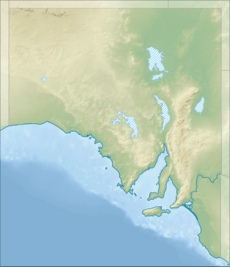Ferries McDonald Conservation Park facts for kids
Quick facts for kids Ferries McDonald Conservation ParkSouth Australia |
|
|---|---|
|
IUCN Category III (Natural Monument)
|
|
| Nearest town or city | Murray Bridge |
| Established | 28 July 1938 |
| Area | 8.42 km2 (3.3 sq mi) |
| Managing authorities | Department for Environment and Water |
| Website | Ferries McDonald Conservation Park |
| Footnotes | Managing authority |
| See also | Protected areas of South Australia |
Ferries McDonald Conservation Park is a special protected area in South Australia, Australia. It's found near Murray Bridge, about 10 kilometers (6 miles) to the southwest. This park covers a large area of 845 hectares (about 2,088 acres).
It's a safe home for many native animals and plants, including some that are endangered. The park is one of the last remaining areas of natural mallee bushland in the region. Groups are working to protect and connect these important patches of land. This helps rare and endangered species have a better chance to survive.
Ferries McDonald Conservation Park is open for everyone to visit. You can enjoy walking trails and go bird watching there. It's a great place to see nature up close!
Contents
History of the Park
A long time ago, most of the land around the park was cleared for farming. But some rocky areas were not good for crops. These spots kept their original plants and trees.
A kind landowner named Robert Sweet McDonald gave some of his land to protect this mallee bushland. He wanted to show what the area used to look like. More land was added to the park later on.
Animals and Nature (Ecology)
Ferries McDonald Conservation Park was once part of a huge mallee bushland. This was before many people lived in the area. It's located on the Murray plains. Many native shrubs grow here, creating an "open scrub" habitat.
This habitat supports lots of native animals. You might see Red, Western Grey, and Euro Kangaroos. Emus also live here. There are many different kinds of native birds too.
Bird species include the White-plumed honeyeater, Yellow Plumed Honeyeater, and Fairy Wrens. You can also spot Thornbills, Robins, Lorikeets, Galahs, Mallee Ringnecks, and Red Wattlebirds. Sadly, some smaller animals like Bilbies and Bush Stone-curlews are now gone. This is because of predators like foxes and feral cats. The park is also home to many insects, like tenebrionid beetles, and Australasian ground spiders.
Protecting the Malleefowl
A very important bird in the park is the Malleefowl (Leipoa ocellata). This native bird used to live all over the mallee environment. But Malleefowl are easy targets for foxes and feral cats. Now, they are only found in a few places in Australia, including Ferries McDonald Conservation Park.
Malleefowl are considered vulnerable across Australia. They are critically endangered in the Northern Territory and Western Australia. The park has a small group of Malleefowl. Experts from the National Malleefowl Recovery Team (NMRT) and the Department of Environment and Natural Resources (DENR) watch them closely.
They check how many Malleefowl are seen and how active their nests are each year. These teams work together to track the Malleefowl's progress. They also protect and manage the park in many ways. This includes controlling fires, planting new trees, and managing pest animals.
Zoos South Australia (SA) has even collected Malleefowl eggs from the park before. Their goal was to raise Malleefowl in captivity. Then, they could release them back into other mallee areas.
Plants (Flora)
Besides native animals, Ferries McDonald Conservation Park has many rare and endangered plants. One special plant is the Resin Wattle (Acacia rhetinocarpa). This is a small, bushy shrub that grows up to 2 meters (6.5 feet) tall. It has bright yellow flowers.
This plant is only found in South Australia. There are only a few places where it grows. Three of these important groups of Resin Wattles are found right here in Ferries McDonald Conservation Park.
Managing Bushfires
Large areas of mallee bushland can easily catch fire. The Department of Environment and Natural Resources (DENR) works with volunteers. They carry out important tasks in the park and nearby areas. Their goal is to reduce the amount of "fuel" for fires, like dry plants. This lowers the risk of a big bushfire.
They use different methods to do this. They manually remove extra plants. They also create firebreaks, which are clear areas that stop fires from spreading. Sometimes, they do controlled burns. They also use mulching to help manage the land.
Dealing with Invasive Species
Like many places in Australia, Ferries McDonald Conservation Park has introduced animals. These are species that don't naturally belong there. They include feral cats, foxes, and rabbits. The park does not have fences to keep these animals out.
The Department of Environment and Natural Resources runs programs to control these pest animals. They use baiting programs. These efforts aim to get rid of pest species in the wider Murray Darling Basin area.


